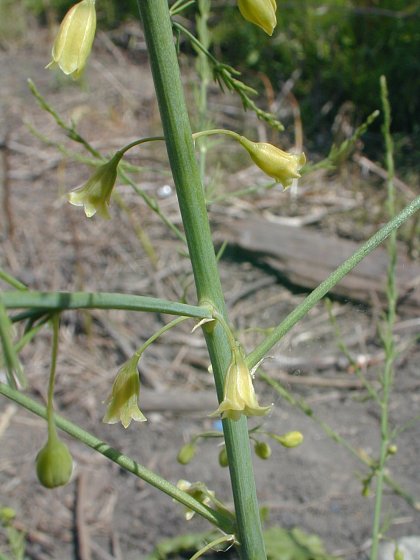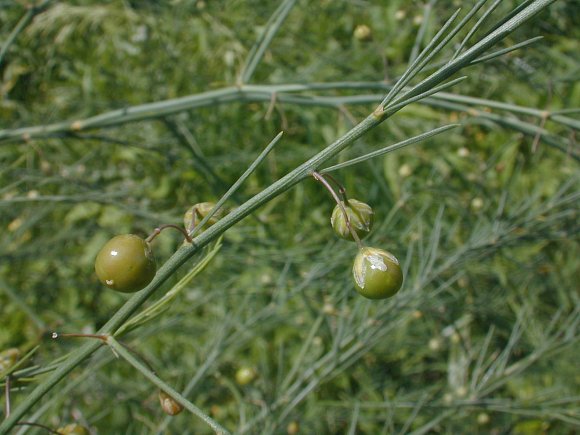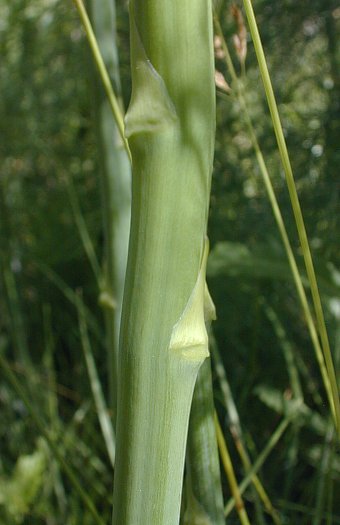Description: This herbaceous perennial plant is 2½–7' tall at maturity, branching occasionally. At the base of the plant, the primary stem is relatively stout (up to 1" across) and angular-terete. Small alternate leaves are appressed against this stem; they are light yellow to purple, deltate in shape, and scale-like in appearance. As the primary stem continues to lengthen, it develops alternate secondary stems that are more slender and either ascending or widely spreading. These secondary stems also have alternate leaves that are even smaller in size, scale-like in appearance, and appressed. Both the primary stem and secondary stems are grayish green, glabrous, and sometimes glaucous. Along the secondary stems and upper half of the primary stem, there are whorls of 4-15 stemlets (cladophylls) that resemble needle-like leaves; they develop from the axils of scale-like leaves. Relative to their stems, these stemlets are ascending to widely spreading; the latter are ¼–1¼" long, about 1 mm. across, grayish green to green, glabrous, and narrowly linear in shape.

Sometimes either solitary or clusters of 2-3 nodding flowers develop from the axils of leaves. The pedicels of these flowers are up to 1" long and glabrous. Individual plants can develop either all male (staminate) flowers, all female (pistillate) flowers, or a mixture of unisexual and perfect (bisexual) flowers. Individual flowers are up to 8 mm. (1/3") long and narrowly bell-shaped (campanulate), consisting of 6 lanceolate-oblong tepals that are either greenish white or greenish yellow. The tepals are joined together, except at their tips, where they are either recurved or straight. Male flowers have 6 stamens with yellow anthers, while female flowers have a pistil with a single style; perfect flowers have both stamens and a pistil. The blooming period occurs during early to mid-summer, lasting about 3-4 weeks. Afterwards, fertile female flowers are replaced by fleshy berries that become about 6-8 mm. across at maturity. The berries are globoid in shape and glabrous; they are initially green to yellowish green, but they become red at maturity. Remnants of the shrunken tepals often persist where the pedicels join the berries; each berry usually contains 2-4 seeds inside. The root system produces rhizomes that are long and spreading. As a result, clonal colonies of plants often develop.

Cultivation:
The preference is full sun and moist to slightly dry conditions. This
plant grows readily in soil that contains loam, sand, or gravelly
material; it forms clonal colonies more readily in soil that is
sandy or somewhat loose and gritty. Growth and develop during the late
spring and early summer is very rapid. When the vernal stems are about
6" long, they can be cut at their bases and prepared like cultivated
asparagus. However, the soil should not be contaminated with toxic
chemicals; contaminated soil is common along roadsides and railroads.
Wild Asparagus appears to have fewer problems
with disease organisms than some cultivated varieties of asparagus.
This plant can spread aggressively
in some situations, and it is resistant to some commonly-applied
herbicides (e.g., those targeting dicots).
Range & Habitat:
The non-native Wild Asparagus is a fairly common plant that occurs in
most counties of
Illinois (see Distribution
Map).
Official records probably underestimate its true
distribution. This plant was introduced into North America from Europe
as a cultivated vegetable. It has been cultivated as an edible
vegetable since antiquity, and it is still popular as a vegetable
today. Naturalized plants can be found in such habitats as black soil
prairies, grassy
meadows, thickets, fence rows, powerline clearances in wooded areas,
abandoned fields, vacant lots, gravelly areas along railroads, grassy
roadsides, and
waste areas. Typical, sandy, or gravelly habitats with a history of
disturbance are preferred. However, Wild Asparagus can invade
high quality natural areas to some extent.

Faunal Associations: The nectar and pollen of the flowers attract small- to medium-sized bees. In Germany, Müller (1873/1883) observed honeybees, mason bees (Osmia spp.), masked bees (Hylaeus spp.), Halictid bees, and the leaf-cutting bee, Megachile centuncularis, visiting the flowers. In Wisconsin and Illinois, Graenicher (1907) and Robertson (1929) observed similar bees, including the same leaf-cutting bee as Müller. Some insects feed destructively on the foliage and other parts of both cultivated and Wild Asparagus. This includes both the adults and larvae of Crioceris asparagi (Asparagus Beetle), Crioceris duodecimpunctata (Spotted Asparagus Beetle), and Lilioceris lilii (Lily Leaf Beetle). Other insect feeders include the larvae of Ophiomyia simplex (Asparagus Miner Fly), Brachycorynella asparagi (Asparagus Aphid), the larvae of Anacamptodes humaria (Small Purplish Gray) and other moths, Euschistus servus (Brown Stink Bug) and other stink bugs, Atlanticus testaceus (Protean Shieldback), Scudderia curvicauda (Curve-tailed Bush Katydid), and other species in the Orthoptera (Clark et al., 2004; Spencer & Steyskal, 1986; Cranshaw, 2004; Covell, 1984/2005; Rider, 2009; Gangwere, 1967; Gangwere, 1961). The red berries of Wild Asparagus are distributed by birds, but information about this for North America is limited. According to Beal (1915), the berries are eaten by the Eastern Bluebird to a minor extent. Swanson (1952) reported that both the Ring-necked Pheasant and Coyote sometimes eat the berries as emergency food. While the young shoots of Wild Asparagus are tender and edible, at maturity they become stringy and tough. Cattle have reportedly been poisoned from the consumption of mature plants.

Photographic
Location:
Along a railroad in Champaign, Illinois.
Comments:
Wild Asparagus is the same species as the asparagus that is cultivated
in gardens, except that it has escaped into uncultivated areas, where
it often persists. This is an odd-looking plant of the Lily family with
insignificant scale-leaves and a spindly appearance. What appears to be
needle-like leaves along the stems, are whorls of linear stemlets;
these stemlets are not true leaves. Although the flowers are produced
in abundance on large healthy plants, they are not very showy. Most
dioecious plants in Illinois with either all male or all female flowers
are wind-pollinated. However, Wild Asparagus is an exception because it
is insect-pollinated.